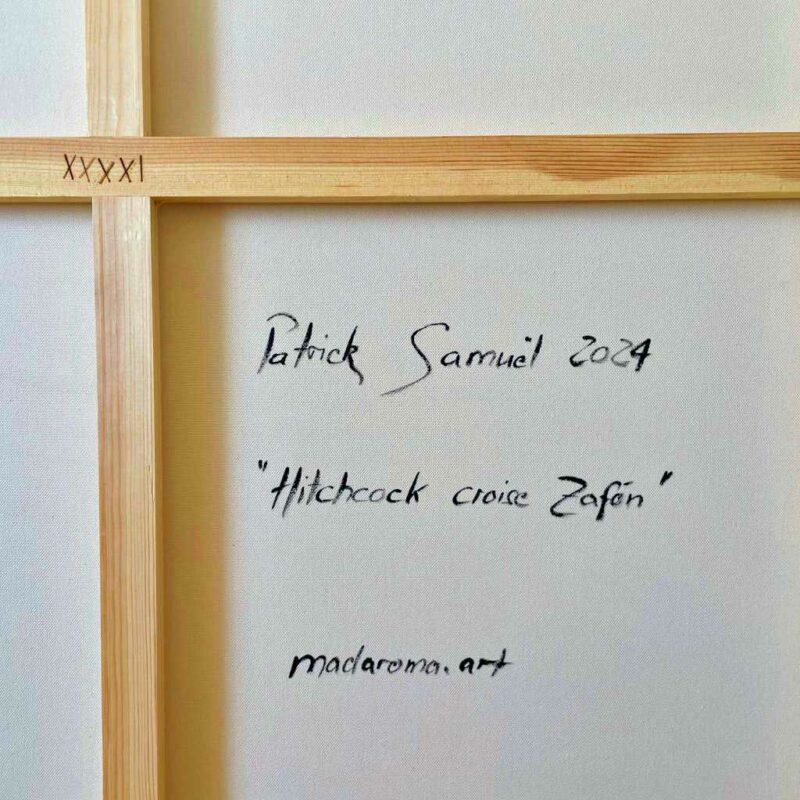Faded out
Original painting by Patrick Samuël
- Mixed media as oil, gold leafs or chinese ink on canvas — on supported wooden frame
- Original artwork with a certificate of authenticity, signed by the artist
- Ready to hang
- Framing on request
Patrick Samuël’s expressive works of art add class to any room. They capture the scent of the wide world in all its facets and have an inspiring effect on the viewer. A powerful expression, a unique vision and the vigour of joie de vivre are common to all his paintings.
To prevent copyright abuse, all images are watermarked. The original artworks are not, of course.
Ausgeblendet
Originalgemälde von Patrick Samuël
- Mischrechnik wie Öl, Blattgold oder Tusche auf Leinwand – auf hölzernem Keilrahmen
- Originalkunstwerk mit einem vom Künstler signierten Echtheitszertifikat
- Bereit zum Aufhängen
- Einrahmung auf Anfrage
Die ausdrucksstarken Kunstwerke von Patrick Samuël verleihen jedem Raum Klasse. Sie fangen den Duft der weiten Welt in all ihren Facetten ein und haben eine inspirierende Wirkung auf den Betrachter. Ein kraftvoller Ausdruck, eine einzigartige Vision und die Kraft der Lebensfreude sind allen seinen Gemälden gemein.
Um Urheberrechtsmissbrauch zu verhindern, sind alle Bilder mit einem Wasserzeichen versehen. Die originalen Kunstwerke sind es natürlich nicht.
Effacé
Peinture originale de Patrick Samuël
- Technique mixte comme huile, feuilles d’or ou encre de Chine sur toile – sur châssis en bois
- Œuvre originale avec certificat d’authenticité, signée par l’artiste
- Prêt à suspendre
- Encadrement sur demande
Les œuvres d’art expressives de Patrick Samuël ajoutent de la classe à chaque pièce. Elles capturent le parfum du vaste monde sous toutes ses facettes et ont un effet inspirant sur le spectateur. Une expression puissante, une vision unique et la force de la joie de vivre sont communes à toutes ses toiles.
Pour éviter les abus en matière de droits d'auteur, toutes les images sont marquées d'un filigrane. Les œuvres d'art originales ne le sont pas, bien entendu.
About the »KISS OF THE SMARTPHONE« series
The evolution of viewing habits is a fascinating phenomenon, deeply rooted in our technological progress and cultural changes. The field of our vision, which describes the space visible to the naked eye, generally has a ratio of around 5:3, which corresponds to a natural wide format. These natural limits to our perception have also shaped our artistic and media representation.
The era of wide format
Until 2007, widescreen was the dominant form of image reproduction. Analogue photographs were often produced in the 6:4 format, which corresponds to the human perception of width and height. In the film industry, extreme wide formats were used to create an immersive experience.

The impact of the digital revolution
A paradigm shift began with the introduction of the first iPhone by Apple in 2007. Mobile screens with aspect ratios ranging from 16:9 to 21:9 were increasingly used vertically, restricting our field of vision to a narrow, tall format. This change was not only a technological shift, but also a change in our visual culture.

Narrowing the field of view
By using mobile devices predominantly vertically, we block out the reality to the left and right of the screen.
This narrowing of the field of vision leads to a more focused, but also more limited, perception. The vertical composition of images has given rise to new trends and aesthetics, particularly in social media and content creation.
The rise of the selfie, which emerged after 2007, reorients the individual as the focal point of a portrait-centred reality, obscuring broader contexts. This phenomenon fuels a societal shift towards self-centredness and narcissism, fragmenting collective cohesion.
Philosophical implications
This shift in our viewing habits has profound philosophical implications. It reflects how technology is changing not only our perception, but also our understanding of reality and aesthetics. It raises the question of whether, by narrowing our visual frame, we are also narrowing our mental perspective.
Can we fully grasp the breadth and depth of the world by focusing on narrow, predetermined frames?
Reflecting on this development challenges us to question our viewing habits and how technology shapes our perception and understanding of the world. In a time of rapid technological change, it remains essential to take a critical look at the impact of these developments on our lives and perceptions.
Metaphorical Interpretation of the »Kiss of the Smartphone«
The term is a reference to the »Kiss of the spider« and symbolizes something that is deceptively attractive but dangerous, similar to how a spider's web is beautiful but deadly to its prey.
Über die serie »KISS OF THE SMARTPHONE«
Die Evolution der Sehgewohnheiten ist ein faszinierendes Phänomen, das tief in unserem technologischen Fortschritt und kulturellen Wandel verankert ist. Das Gesichtsfeld, das den für ein unbewegtes Auge sichtbaren Raum beschreibt, hat in der Regel ein Verhältnis von etwa 5:3, was einem natürlichen Breitformat entspricht. Diese natürlichen Grenzen unserer Wahrnehmung haben auch unsere künstlerische und mediale Darstellung geprägt.
Die Ära des Breitformats
Bis 2007 war das Breitbildformat die vorherrschende Form der Bildwiedergabe. Analoge Fotografien wurden häufig im Format 6:4 produziert, das der menschlichen Wahrnehmung von Breite und Höhe entspricht. In der Filmindustrie wurden extrem breite Formate verwendet, um ein immersives Erlebnis zu schaffen.

Der Einfluss der digitalen Revolution
Mit der Einführung des ersten iPhones von Apple im Jahr 2007 begann ein Paradigmenwechsel. Mobile Bildschirme mit Seitenverhältnissen von 16:9 bis 21:9 wurden zunehmend vertikal genutzt und schränkten unser Blickfeld auf ein schmales, hohes Format ein. Diese Veränderung war nicht nur ein technologischer Wandel, sondern auch ein Wandel in unserer visuellen Kultur.

Die Verengung des Gesichtsfelds
Durch die überwiegend vertikale Nutzung mobiler Geräte blenden wir die Realität links und rechts des Bildschirms aus.
Diese Verengung des Blickfeldes führt zu einer fokussierteren, aber auch eingeschränkteren Wahrnehmung. Die vertikale Komposition von Bildern hat neue Trends und eine neue Ästhetik hervorgebracht, insbesondere in den sozialen Medien und bei der Erstellung von Inhalten.
Der Aufstieg des Selfies, der nach 2007 einsetzte, rückt das Individuum in den Mittelpunkt einer porträtzentrierten Realität und verdeckt breitere Zusammenhänge. Dieses Phänomen fördert einen gesellschaftlichen Wandel hin zu Egozentrik und Narzissmus, der den kollektiven Zusammenhalt fragmentiert.
Philosophische Implikationen
Diese Veränderung unserer Sehgewohnheiten hat tiefgreifende philosophische Auswirkungen. Sie zeigt, wie die Technologie nicht nur unsere Wahrnehmung, sondern auch unser Verständnis von Realität und Ästhetik verändert. Sie wirft die Frage auf, ob wir durch die Verengung unseres visuellen Rahmens auch unsere geistige Perspektive einschränken.
Können wir die Weite und Tiefe der Welt vollständig erfassen, wenn wir uns auf einen engen, vorgegebenen Rahmen konzentrieren?
Die Reflexion über diese Entwicklung fordert uns auf, unsere Sehgewohnheiten zu hinterfragen und uns bewusst zu machen, wie Technologie unsere Wahrnehmung und unser Verständnis der Welt formt. In einer Zeit rasanter technologischer Veränderungen bleibt es essentiell, einen kritischen Blick auf die Auswirkungen dieser Entwicklungen auf unser Leben und unsere Wahrnehmung zu werfen.
Metaphorische Interpretation des »Kiss of the Smartphone«
Der Begriff ist eine Anspielung auf den »Kuss der Spinne« und symbolisiert etwas, das trügerisch attraktiv, aber gefährlich ist, ähnlich wie das Netz einer Spinne schön, aber tödlich für ihre Beute ist.
À PROPOS DE LA SERIE « KISS OF THE SMARTPHONE »
L’évolution des habitudes visuelles est un phénomène fascinant, profondément ancré dans nos progrès technologiques et nos changements culturels. Le champ de vision, qui décrit l’espace visible à l’œil nu, a généralement un rapport d’environ 5:3, ce qui correspond à un format large naturel. Ces limites naturelles de notre perception ont également façonné notre représentation artistique et médiatique.
L’ère du format large
Jusqu’en 2007, l’écran large était la forme dominante de reproduction des images. Les photographies analogiques étaient souvent produites au format 6:4, qui correspond à la perception humaine de la largeur et de la hauteur. Dans l’industrie cinématographique, des formats extrêmement larges étaient utilisés pour créer une expérience immersive.

L’impact de la révolution digitale
Un changement de paradigme s’est amorcé avec l’introduction du premier iPhone par Apple en 2007. Les écrans mobiles, dont les proportions varient de 16:9 à 21:9, sont de plus en plus utilisés à la verticale, ce qui restreint notre champ de vision à un format étroit et haut. Ce changement n’était pas seulement un changement technologique, mais aussi un changement dans notre culture visuelle.

Réduction du champ de vision
By using mobile devices predominantly vertically, we block out the reality to the left and right of the screen.
En utilisant les appareils mobiles principalement à la verticale, nous bloquons la réalité à gauche et à droite de l’écran.
L’essor du selfie, apparu après 2007, réoriente l’individu comme point central d’une réalité centrée sur le portrait, occultant des contextes plus larges. Ce phénomène alimente une évolution sociétale vers l’égocentrisme et le narcissisme, fragmentant la cohésion collective.
Implications philosophiques
Ce changement dans nos habitudes télévisuelles a de profondes implications philosophiques. Il reflète la manière dont la technologie modifie non seulement notre perception, mais aussi notre compréhension de la réalité et de l’esthétique. Il soulève la question de savoir si, en rétrécissant notre cadre visuel, nous rétrécissons également notre perspective mentale.
Pouvons-nous saisir pleinement l’étendue et la profondeur du monde en nous concentrant sur des cadres étroits et prédéterminés ?
Réfléchir à cette évolution nous incite à remettre en question nos habitudes télévisuelles et la manière dont la technologie façonne notre perception et notre compréhension du monde. À une époque où les technologies évoluent rapidement, il est essentiel de porter un regard critique sur l’impact de ces développements sur nos vies et nos perceptions.
Interprétation métaphorique du « Kiss of the Smartphone » (baiser du smartphone)
Ce terme fait référence au « Kiss of the spider » (baiser de l'araignée) et symbolise quelque chose de faussement attirant mais dangereux, à l'instar de la toile d'araignée, belle mais mortelle pour ses proies.
The Verso of paintings
The verso of all original paintings contain the following:
- A branded Roman numeral on the frame
- The artist’s signature
- The original title in French
- The URL of this website
Rückseite der Gemälde
Die Rückseiten aller Originalgemälde enthalten folgende Angaben:
- Eine eingebrannte römische Zahl auf dem Rahmen
- Die Signatur des Künstlers
- Den Originaltitel in französischer Sprache
- Die URL dieser Website
Le Verso des peintures
Le verso de toutes les peintures originales contient les éléments suivants :
- Un chiffre romain marqué sur le cadre
- La signature de l’artiste
- Le titre original en français
- L’URL de ce site web
ABOUT Patrick Samuël
Patrick Samuël, born in 1964, is an artist and adventurer, well-educated, gentle in spirit but wild at heart. He is a French-Swiss dual citizen. He lived in several countries and grew up multilingual. Artistic talent and the scent of the wide world are in his DNA.
Get in touch with the artist
Would you like to visit the studio or schedule a video call with Patrick Samuël to view his works?
You can reach him at contact (at) madaroma.art
Über Patrick Samuël
Patrick Samuël, geb. 1964, ist ein Künstler und Abenteurer, wohlerzogen, sanft im Gemüt, aber wild im Herzen. Er ist französisch-schweizerischer Doppelbürger. Er lebte in mehreren Ländern und wuchs mehrsprachig auf. Künstlerisches Talent und der Duft der weiten Welt liegen in seiner DNA.
Nehmen Sie Kontakt mit dem Künstler auf
Möchten Sie das Atelier besuchen oder einen Videoanruf mit Patrick Samuël vereinbaren, um seine Werke zu betrachten?
Sie erreichen ihn unter contact (at) madaroma.art
À propos de Patrick Samuël
Patrick Samuël, né en 1964, est un artiste et aventurier, bien élevé, doux d’esprit mais sauvage de cœur. Il a la double nationalité franco-suisse. Il a vécu dans plusieurs pays et a grandi multilingue. Le talent artistique et le parfum du vaste monde sont inscrits dans son ADN.
Entrez en contact avec l’artiste
Vous souhaitez visiter l’atelier ou planifier un appel vidéo avec Patrick Samuël pour voir ses œuvres ?
Vous pouvez le contacter à contact (at) madaroma.art








